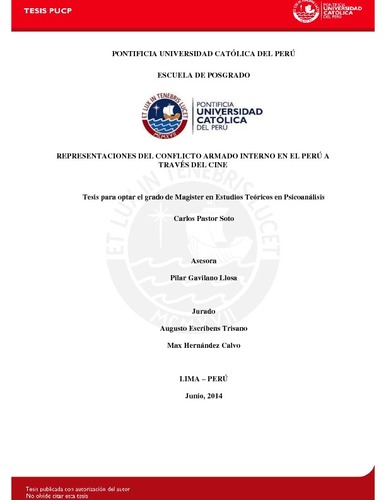| dc.contributor.advisor | Gavilano Llosa, María Pilar | |
| dc.contributor.author | Pastor Soto, Carlos | es_ES |
| dc.date.accessioned | 2014-10-30T21:42:40Z | es_ES |
| dc.date.available | 2014-10-30T21:42:40Z | es_ES |
| dc.date.created | 2014 | es_ES |
| dc.date.issued | 2014-10-30 | es_ES |
| dc.identifier.uri | http://hdl.handle.net/20.500.12404/5682 | |
| dc.description.abstract | La presente investigación cualitativa pretende analizar algunas representaciones del conflicto armado interno en el Perú a partir de la observación de dos de las primeras películas que trataron este tema, una producción limeña y una ayacuchana. Las películas fueron tomadas como construcciones dinámicas, y a partir de éstas surgieron los temas del conflicto con la figura paterna y sus roles de autoridad y protección, la experiencia de lo ominoso (el terror frente a una amenaza que se vive a partir del encuentro con espacios y figuras que convencionalmente se consideran seguras y familiares), y el funcionamiento de grupos humanos involucrados en el conflicto. Estas películas darían cuenta de un modo de representación del conflicto armado interno peruano bajo la influencia de una serie de escisiones y a la vez suponen la posibilidad de una reparación simbólica. El análisis de ambos filmes fue realizado bajo el marco de la teoría psicoanalítica. | es_ES |
| dc.description.abstract | The following qualitative research intends to analyze some representations of the "armed internal conflict" in Peru. These representations were abstracted from two of the first films that came out and dealt with that topic; one film being a production from Lima, the other from Ayacucho. The films were treated as dynamic constructions, which lit up several topics. We focused on the following three: (1) the conflict with the paternal figure and its authority and protective roles, (2) the uncanny experience (the terror experiencing a threat in the encounter with spaces and figures which conventionally would be considered as safe and familiar), and (3) the internal functioning of some groups involved in the conflict. It is our view, that both films imply a representation of the "armed internal conflict" which is based on splitting. However, they open up, at the same time, the possibility for a symbolic reparation. The analysis of the two films was made within the psychoanalytic theoretical framework. | es_ES |
| dc.language.iso | spa | es_ES |
| dc.publisher | Pontificia Universidad Católica del Perú | es_ES |
| dc.rights | Atribución-NoComercial-SinDerivadas 2.5 Perú | * |
| dc.rights | info:eu-repo/semantics/openAccess | es_ES |
| dc.rights.uri | http://creativecommons.org/licenses/by-nc-nd/2.5/pe/ | * |
| dc.subject | Representación mental | es_ES |
| dc.subject | Psicoanálisis y cine | es_ES |
| dc.subject | Conflicto armado--Perú | es_ES |
| dc.subject | Cine peruano | es_ES |
| dc.title | Representaciones del conflicto armado interno en el Perú a través del cine | es_ES |
| dc.type | info:eu-repo/semantics/masterThesis | es_ES |
| thesis.degree.name | Magíster en Estudios Teóricos en Psicoanálisis | es_ES |
| thesis.degree.level | Maestría | es_ES |
| thesis.degree.grantor | Pontificia Universidad Católica del Perú. Escuela de Posgrado | es_ES |
| thesis.degree.discipline | Estudios Teóricos en Psicoanálisis | es_ES |
| renati.discipline | 313107 | es_ES |
| renati.level | https://purl.org/pe-repo/renati/level#maestro | es_ES |
| renati.type | http://purl.org/pe-repo/renati/type#tesis | es_ES |
| dc.publisher.country | PE | es_ES |
| dc.subject.ocde | https://purl.org/pe-repo/ocde/ford#5.01.00 | es_ES |






